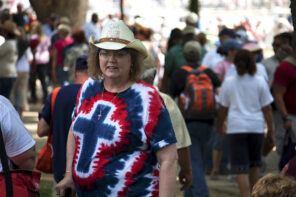SWIMMING AGAINST THE TIDE: RELIGIOUS (NON) AFFILIATION MIGHT NOT MEAN WHAT YOU THINK IT MEANS
By Timothy King
The 2014 U.S. Religious Landscape Study, which is being rolled out in a series of reports this year, depicts a deep shift in how Americans identify (or don’t) with religion. It’s tempting to approach the latest report, and those to follow, with attention grabbing headlines that portray the complex statistics as a simplistic counting of which way the proverbial “fish” are swimming.
To do so would be a grand mistake.
CRITIQUES, QUESTIONS, AND SAUVE-QUI-PEUT: LOOKING TOWARD THE FUTURE OF AMERICAN CHRISTIANIT(IES)
By Peter Laarman
The terrain is indeed shifting as the latest Pew survey results suggest, but it’s not a simple matter of secularization or non-affiliation. My own working assumption is that many of those who will no longer answer “Christian” in answer to polling questions will still be drawn to Jesus as an ethical icon, as a theophanous human being, and as a social revolutionary, for a long time to come.
WHAT THE NUMBERS DON’T TELL US: RELIGION IS A LIVED, SHIFTING EXPERIENCE
By Kaya Oakes
Having spent most of the last two years in conversation with Nones, seekers, doubters, and those who feel culturally bound to a religious tradition even while they don’t participate in one, the latest Pew survey results come as no surprise. It’s been clear for years that Mainline Protestant Christianity in America is on the decline.
That Catholicism also is in precipitous decline—and the news that the religiously unaffiliated now outnumber Catholics—is perhaps only surprising to those who haven’t attended a Catholic church recently.
U.S. CHRISTIANITY IS DEAD, LONG LIVE U.S. CHRISTIANITY
By Richard Flory
In the cluster of comment on the recently released report on the changing American religious landscape from the Pew Research Center, we have seen two basic story lines: the U.S. is “less Christian” now than it was seven years ago—by about 8 percent, and the population of “nones” has increased, from 16 percent in 2007 to 23 percent this time around.
As bad as those numbers may sound for religious groups, things are actually even worse. The report only shows how many people consider themselves Catholic, Jewish, Baptist or “nothing in particular.” What this leaves out (which I suspect will be detailed in future reports) is what these religious identities mean as measured by attendance at services or participation in religious community.
PREDICTING THE FUTURE OF RELIGION: A THOUGHT EXPERIMENT
By Ed Simon
This week’s news from Pew on the decline of institutional Christianity, with its trove of data on the “unaffiliated” and the decline of the mainstream, has stolen the stage from last month’s release of Pew’s report on the Future of World Religions—a study that concluded that while atheists, agnostics and the unchurched are on the rise in the U.S. their numbers are projected to decline globally. But while Pew’s prediction that Islam will overtake Christianity made headlines, the authors of the study were quick to remind us that their findings are not the direct results of polling but projections.
PEW CONFIRMS LGBT REJECTION OF RELIGION: WHY THAT’S A GOOD THING
By Candace Chellew-Hodge
When a book such as Matthew Vines’ God and the Gay Christian becomes a smash hit it might lead you to think that there is a large contingent of lesbian, gay, bisexual and transgender Christians out there clamoring for acceptance.
But a new report from the Pew Research Center suggests that this is not the case.
As it turns out Vines’ book (and others that seek to reconcile LGBT lives with fundamentalist Christian teaching) is only a big deal to insiders—or to a voyeuristic public that doesn’t have any real skin in the game.
SIX OVERLOOKED GEMS FROM THE FUTURE OF WORLD RELIGIONS REPORT
By Timothy King
The global religious landscape is changing, fast, and The Future of World Religions reportfrom the Pew Research Center has boldly gone where no exceptionally long research group report has gone before by extrapolating current trends to draw a spiritual picture of the world in 2050.*
The report is careful to acknowledge that a lot could change between now and 2050. War, famine, pandemics, and general political instability, for example, could knock these trends off track given that the greatest driving factors for change are determined by age of the population, life expectancy, and fertility rates.





